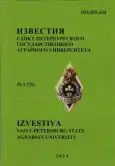Protection of Winter Wheat Against Pests
- Authors: Al-Maliki A.S.1, Isawi M.B.2, Khilevsky V.A.3,4
-
Affiliations:
- Ministry of Agriculture of Iraq
- Saint-Petersburg State Agrarian University
- All Russia Research Institute for Plant Protection
- Innovation Center for Plant Protection
- Issue: No 1(75) (2024)
- Pages: 36-47
- Section: Agronomy, forestry and water management
- URL: https://bakhtiniada.ru/2078-1318/article/view/304750
- DOI: https://doi.org/10.24412/2078-1318-2024-1-36-47
- ID: 304750
Cite item
Full Text
Abstract
Chemical control of pest populations is of great importance because of the possibility of its immediate use in the event of serious phytosanitary situations, as well as its high biological and economic efficiency. One advantage of the studied preparations is their low application rate, which is consistent with one of the important criteria for evaluating the level of environmental safety of pesticides. The research was conducted in the Salsky district of the Rostov Region in 2021-2022. The aim of the research is to evaluate the effectiveness and develop regulations for the use of modern combined pesticides: a herbicide containing 225 g/l tribenuron-methyl and 76 g/l thifensulfuron-methyl and an insecticide containing 112 g/l bifenthrin and 37 g/l sulfoxaflor. The following varieties of Winter Wheat (Triticum aestivum L.) were used in the experiments: Svarog (2021), Yuka (2022). The growth stage of wheat plants at the time of treatment with pesticides - tillering or exit into the tube. Biological efficacy of an herbicide containing 225 g/l tribenuron-methyl and 76 g/l tifenesulfuron-methyl, oil dispersion (OD), as mixed with surfactant Bit 90, liquid (L), and in its pure form was at the level of effectiveness of the standard Caliber Gold, water-dispersible granules (WDG), both in a mixture with surfactant Trend 90, L, and in its pure form in the relevant regulations for use. Using the drug was safe for the protected crop. The study of the biological effectiveness of a combined insecticide containing 112 g/l of bifenthrin and 37 g/l of sulfoxaflor, suspension emulsion (SE) against a dangerous phytophage that harms Winter Wheat, Cereal Leaf Beetle (Oulema melanopus L.), was carried out according to the scheme: the studied drug at application rates of 0.2 l/ha, 0.3 l/ha, 0.4 l/ha, the stander drug Clonrin, emulsion concentrate (EC) at a rate of 0.2 l/ha and control without treatment. Phase of culture development at the time of treatment: exit into the tube. An assessment of the biological effectiveness of the insecticide under study showed that the drug reduced the number of hogweed larvae by up to 95.8%. The experimental drug at three application rates (0.2, 0.3 and 0.4 l/ha) corresponded to the effectiveness of the standard Clonrin, EC at the application rate of 0.2 l/ha and even exceeded it.
About the authors
A. S. Al-Maliki
Ministry of Agriculture of Iraq
Email: ali77.2013@yahoo.com
Head of the Department of Pesticides, member and Speaker of the National Committee for Registration and Approval of Pesticides
Abu Ghraib, Baghdad, IraqM. B. A. Isawi
Saint-Petersburg State Agrarian University
Email: mohanad_bahar@yahoo.com
postgraduate student
Pushkin, Saint Petersburg, RussiaV. A. Khilevsky
All Russia Research Institute for Plant Protection; Innovation Center for Plant Protection
Author for correspondence.
Email: 89281485089@mail.ru
Cand. Sci. (Agric.)
Pushkin, St. Petersburg, Russia; Pushkin, St. Petersburg, RussiaReferences
- Lachuga, Yu. F., Plugatar, Yu.V., Makrushin, N.M. [et al.] (2019). The most important provisions of the concept of strategic development of seed production and plant reproduction in the Russian Federation. Bulletin of the State Nikitsky Botanical Garden. 132, pp. 9–16. – doi: 10.25684/NBG.boolt.132.2019.01.
- Zubko, N. G. and Dolzhenko, T.V. (2022) ‘Effect of fungicides on the content of photosynthetic pigments in spring wheat plants’, Agrarian Science, vol. 12, pp. 110–118. doi: 10.32634/0869-8155-2022-365-12-110-118.
- Zubko, N.G. and Dolzhenko, T.V. (2023) ‘Effectiveness of triazole fungicide for protection of spring wheat during the growing season’, Fertility, vol. 5, pp. 95–98. doi: 10.25680/S19948603.2023.134.24.
- Sanin, S. S, Karlova, L.V. and Kashcheev, A.V. (2022) ‘Economic and agroecological aspects of chemical protection of grain crops from harmful organisms’, Protection and quarantine of plants, vol. 5, pp. 3–13.
- Kashyap, P.L, Gupta, V., Gupta, O, P. Sendhil, R. Gopalareddy, K. Jasrotia, P. and Singh,
- G.P. (2022) ‘New horizons in wheat and barley research: crop protection and resource management’, Springer, p. 637, https://doi.org/10.1007/978-981-16-4134-3.
- Dolzhenko, V.I., Zakharchenko, G.I., Burkova, L.A., Ivanova, G.P., Vasilyeva, T.I. Dolzhenko, O.V. and Laptiev A.B. (2021) ‘Improving the assortment of plant pest control products in the XI century’, Agrochemistry, no. 1. pp. 31–40. doi: 10.31857/S000218812101004X.
- Dolzhenko, V.I., Sukhoruchenko, G.I. and Laptiev, A.B. (2022) ‘Development of the chemical method of plant protection in Russia’, Protection and quarantine of plants, vol. 4, pp. 3–13.
- Gyawali, A., Bhandari, R., Budhathoki, P. and Bhattarai, S. (2022) ‘Review on Effect of Weeds in Wheat (Triticum aestivum L.) and Their Management Practices’, Food and Agri Economics Review, vol. 2, no. 2, pp. 34–40.
- Guidelines for conducting registration tests of herbicides, St. Petersburg, 2020. 80 p.
- Dolzhenko V.I., Sukhoruchenko, G.I., Burkova, L.A. [etc.] (2022) Guidelines for registration testing of insecticides, acaricides, pheromones, molluscicides and rodenticides in plant growing. Moscow: FGBNU “Rosinformagrotekh”. 508 p.
- Isavi, M.B.A., Khilevsky, V.A., Dolzhenko, T.V. (2023) ‘Combined insecticide for the protection of Winter Wheat from bread beetles’, News of the Saint-Petersburg State Agrarian University, vol. 71, no. 2, pp. 38–46. doi: 10.24412/2078-1318-2023-2-38-46.
Supplementary files









